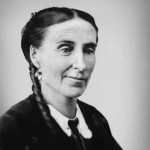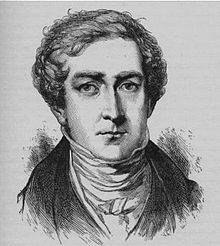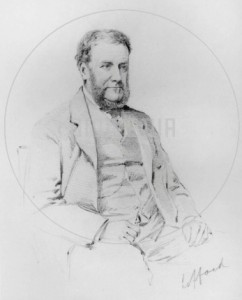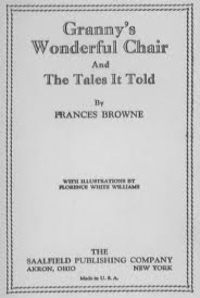 Frances Browne was born at Upper Main St. Stranorlar on the 16 January 1816. She was the seventh of twelve children born to the first Postmaster in Stranorlar. Her father Mr. Samuel Browne was also the local emigration agent for some of the shipping lines to Australia and America. Blinded, the result of smallpox at eighteen months, Frances strove with all the strength of her own will to overcome the handicap of blindness and educate herself. She first took an interest in the meaning of words as a result of attending Sunday service with her parents when she was seven. The Reverend Steel was the minister in Stranorlar at that time. If Frances didn’t understand a word, she persisted in querying adults and friends until the meaning of the word was explained. She did not attend school in her young days, but played around the house and doorway of her home. Many passing locals on entering her father’s post office would have greeted her and in many ways this attention kept her mind alert. Frances’ father had a small rocking chair built for her and there were items like flowers and animals engraved into the timber, which would have helped to improve her sensitive touch.
Frances Browne was born at Upper Main St. Stranorlar on the 16 January 1816. She was the seventh of twelve children born to the first Postmaster in Stranorlar. Her father Mr. Samuel Browne was also the local emigration agent for some of the shipping lines to Australia and America. Blinded, the result of smallpox at eighteen months, Frances strove with all the strength of her own will to overcome the handicap of blindness and educate herself. She first took an interest in the meaning of words as a result of attending Sunday service with her parents when she was seven. The Reverend Steel was the minister in Stranorlar at that time. If Frances didn’t understand a word, she persisted in querying adults and friends until the meaning of the word was explained. She did not attend school in her young days, but played around the house and doorway of her home. Many passing locals on entering her father’s post office would have greeted her and in many ways this attention kept her mind alert. Frances’ father had a small rocking chair built for her and there were items like flowers and animals engraved into the timber, which would have helped to improve her sensitive touch.
Occasionally during the day when her mother had time she would sit with Frances and tell her fairy stories, and as we know the fairies were very popular in Ireland in those days. In later years when Frances became a renowned writer, she understood the value of such stories for children and wrote a famous children’s book called ‘’Granny’s Wonderful Chair’.’
In the evening time when her brothers and sisters were seated around the kitchen to do their homework, they were made to read their prose or poetry aloud so that Frances could listen. It wasn’t long before it was noticed that Frances could recite many verses before her siblings had the work learned. Her talent for poetry developed early, beginning with rewriting the Lord’s Prayer in verse at the age of seven. Her memory was remarkable and her quest for knowledge was insatiable to the point where Frances would bribe her brothers and sisters to read for her as many books as she could lay hands on., She achieved this by carrying out their household chores. At night when they went to bed, Frances would entertain her fellow siblings by telling them stories, and again in many ways this helped develop her mind at that young age.
Mr Mc Granaghan was the local school teacher in those days, and we know that he lent Frances books when she was around thirteen years old. In Frances’ own words:
‘’ My first acquaintance with books was necessarily formed amongst those, which are most common in country villages. Susan Gray, The Negro Servant, The Gentle Shepherd, Mungo Parks Travels and, of course Robinson Crusoe were among the first of my literary friends…’’.
By the age of fifteen she had listened to ‘Hume’s History of England’ and was greatly influenced by Byron’s ‘Child Harold’. Around this time she had read the poems of Burns which were her favourite and on reading the Illiad Frances wrote:
‘’ It was like the discovery of a new world, and effected a total change in my ideas on the subject of poetry. There was at that time, a considerable manuscript of my own productions in existence, which of course, I regarded with some partiality; but Homer had awakened me, and, in a fit of sovereign contempt, I committed the whole to the flames… But after Homer’s, the work that produced the greatest impression on my mind was Byron’s Child Harold. The one had induced me to burn my first manuscript, and the other made me resolve against verse-making in future’’
For several years Frances continued her quest for knowledge but owing to her circumstances her progress was necessary slow. It was around 1840, when on hearing a friend read the story of La Perouse that Frances realized it was remarkably similar to an old country song, called the Lost Ship, which she heard in her childhood. This aroused her interest in writing again and resulted in her penning the poem La Perouse. Frances went on to write many children’s books, novels, poems and articles for newspapers and magazines.
After the publication of ‘La Perouse’ Frances sent three poems to The Irish Penny Journal in 1841 and these poems were ‘Songs of our Land’, ‘The Pilgrim at the Well’, and ‘Ireland’s Wealth. ‘Songs of Our Land’ is one of her best poems and it was published in the school books in 1930.
Songs of our land, ye are with us forever: The power and the splendour of thrones pass away; But yours is the might of some far-flowing river’ Through Summers bright roses or Autumn’s decay;
Then in the spring of 1841 Frances sent a number of poems to the editor of ‘The Athenaeum’ promising, if they were inserted, to send further contributions. She was delighted when one morning she received several numbers of that journal, together with a most flattering letter from the editor, accepting her literary trifles, and encouraging her to continue writing. Her poem ‘Let us Return’ was the premier piece inserted in the Athenaeum on that occasion.
While Frances was residing in Stranorlar she published a book of poems entitled ‘The Star of Atteghei’ and it was really this work which sprung her on to the literary stage and earned her a pension of twenty pounds per annum, granted by Sir Robert Peel from the Royal Bounty Fund. Lord Lifford who lived outside the town of Ballybofey recommended the poetess for this award. Frances loved poetry and later she wrote
‘’I have turned to the more profitable line of Prose though it is not a labour of love as the composition of poetry ever was to me yet taste must at times be sacrificed to interest…’’
Frances was accompanied by her sister Rebecca to Edinburgh in 1847 and on leaving Ireland, she wrote ‘’I go as one that comes no more, yet with no regret. The summers other memories store ‘twere summers to forget.’’ Yet a recurrent theme in her poetry became the exile’s homecoming.
With the help of Professor John Wilson she found employment with Chambers Magazine, and she published her second volume of poems ‘Lyrics and Miscellaneous Poems’ in the same year. She became involved with a wide range of literary and journalistic activities, producing not only poems but news articles, reviews, stories, essays and eventually children’s stories for periodicals such as Chambers, Tait’s Edinburgh Magazine and Ainsworth’s Magazine. She was a contributor to: The Penny Journal, The Athenaeum, Frazer’s and The Keepsake. She wrote articles for Leisure Hour and Sunday at Home. She also had works published by the Religious Tract Society and later she wrote stories about Donegal and Ulster.
Frances moved to London in 1852 and she became the beneficiary of the Marquis of Lansdowne, who on hearing about this talented and struggling writer gave her a gift of 100 pounds. Around this time, her sister Rebecca married a James Davidson who was a mining engineer in Scotland. The loss of a dear family friend was a setback for Frances as she had to employ a more expensive amanuensis. This emotional loss is reflected in the poem ‘Losses’ but Frances was soon back writing and her best work ‘Granny’s Wonderful Chair’ was published in 1857. This collection of fairy tales became a best seller and was republished many times, in many countries around the world. Frances Hodgson Burnett who was the author of ‘The Secret Garden’ retold Browne’s fairy tales in ‘The Story of the Lost Fairy Book’ which became popular in America. This was the first internationally recognized children’s book of fairy tales by an Irish author and the continued sales up to the present time give evidence to its popularity.
Frances wrote three novels ‘The Hidden Sin’, ‘My Share of the World’ and ‘The Castleford Case’. Each book was comprised of three volumes and in recent times these works have received good reviews. In January 2011 a book entitled ‘’Irish Novelists in the Victorian Age’’ by James Murphy had a very positive analysis on ‘My Share of the world’, pointing out its resemblance to the work of Dickens and especially his novel, David Copperfield. Frances’ love of history and geography is evident in works like ‘The Exile’s Trust’, a story of the French Revolution and ‘The Dangerous Guest’, a story set in the time of Bonnie Prince Charlie and King George. In other stories like ‘The Ericksons’ which was her first book for children and in ‘Our Uncle the Traveller’ she takes the reader far and wide. A number of these short stories were read at Sunday school and they were popular in both England and America. In her work ‘The Legends of Ulster’ some of her short stories are set in Donegal.
‘The Star of Atteghei’ is an example of Frances Browne’s ability to write about issues of the day. This conflict is directly related to Russia’s struggle in Chechnya and Frances recognized the similarities to the situation in Poland and events in Ireland with Russia and England as fellow oppressors. The work is unusual in so far as it gives an account of an event regarding an issue of the day recorded in poetry and the work consists of more than one hundred pages. Only the bravest and most talented of poets would undertake such a work.
‘Lyrics and Miscellaneous Poems’ is a book containing a collection of poems which appeared in newspapers and magazines prior to the book being published in 1847.
‘Pictures and Songs of Home’ is a beautiful book of poems and in this book, Frances mentions her mother, sister Mary, along with brothers John and Joseph.
Her brother John became the Presbyterian Minister of First Rye near Manorcunningham. Joseph served as a surgeon in both the British and American navies before settling down in the village of Milford in Oakland County, Michigan. Her sister Martha married Andrew Millar and later they owned the Queen’s Arms Hotel in Stranorlar.
Frances’ last work, which she composed a week before her death, was a poem entitled ‘The Children’s Day’ which appeared in The Sunday at Home.
Records from Richmond show that Frances Browne died from apoplexy in her home at 19 St. John’s Grove, Richmond, Surrey, on 21 August 1879 and she is buried in plot 40 in the cemetery at St Mary Magdalene Church in Richmond. Frances died unmarried and left all her belongings, valued at less than 100 pounds, to Eliza Hickman who had been her faithful companion and secretary for many years.
Many years after her death John Mc Call wrote in ‘Memoirs of Frances Browne’ ‘’… and though she an obscure Irish village maiden for such a lengthened period was thus found worthy to divide the bays with her inspired English sisters, Eliza Cook, Mary Hewitt and her other contemporaries, yet the fame which she thereby acquired, like all terrestrial things, was but ephemeral at the most, as a lengthening shadow imperceptibly fading away, so that this present dull and prosaic age the name of Frances Browne as an Irish popular Lyrist is known but to a very select number indeed’’
Much has been done recently to revive the interest in one of our most gifted students. ‘The Life and Works of Frances Browne’ was published in 2007, the Frances Browne Poetry Competition was launched in 2008, Reverend Blair gave a talk on Frances at the McGill School, Coillte recently erected a boulder in Drumboe woods, and on it, is inscribed a verse from her poem ‘A Parting Voice’. STAG has done much to promote both Frances Browne and Isaac Butt in striving to erect the monuments at ‘The Pound’ Stranorlar. A chance meeting with Selwyn Glynn from Brisbane, who is a relative of our poetess, resulted in the discovery of Frances Browne’s photo. Selwyn’s cousin Marjorie along with her husband and friends visited Stranorlar last year and it is hoped that contact can be made with Frances’ American relatives in the future. Finally, with the help of Susan Doherty and the talented team at Balor it is hoped to produce plays to commemorate the bicentenaries of Isaac in 2013 and Frances in 2016.



